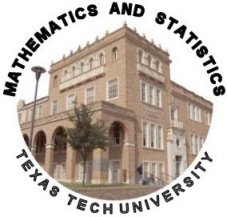Workshops for Students
Cards, magic and the hidden secrets of Math.
Dr. Giorgio Bornia
A magician has a very noble task: to be a generator of Wonder.
It's been said that "a magician never tells his secrets".
Sometimes the secret is just a fast hand, or the sleeve of a shirt.
Other times, it's all about mathematics.
We will talk about some card tricks and (possibly) discover the undiscoverable.
After that, for the sake of Wonder, you are encouraged to keep the undiscoverable to yourself...
Project Lazarus.
John Calhoun, Graduate Student
In the summer of 2013 a group of professors and students at Texas Tech University
began the LAZARUS project. The goal of this project was to transform a small-scale
zombie walk model into a massive simulation, and do so in the most efficient manner.
This was accomplished in two ways. The first way was to adapt the simulation code
to run on graphical processing units since these provide high processing performance
at a low cost. The second way was to build a supercomputer to run this new simulation code.
This computer would be built with standard off-the-shelve computer parts in order to keep costs down.
While this sounds straight forward, this project faced many unforeseen problems and opportunities.
This talk will tell the story of how the project progressed and will stress the
multidisciplinary nature of the project, involving ideas from engineering, geometry, math,
biology, computer science, video gaming, and teaching.
Parallel lines never meet, or do they?
Dr. Lars Christensen
We learn in geometry class that parallel lines never meet,
but every time we let our eyes follow a straight stretch of highway
all the way to the horizon, we doubt it. Of course mathematics has a
way to make sense of what we see. In projective geometry, two parallel
lines do meet in a point infinitely far away! And, actually, a line and a
parabola always have two intersection points, provided that one looks
carefully and counts properly.
Beat the Professor in these math games!
Dr. Jerry Dwyer
We will play some interactive games that challenge students' strategies
and logical thinking skills. The games involve numbers, geometry, and
graphs. We will show how these games help in the type of mathematical
reasoning essential to success in high school and college mathematics.
Time scales fly when you're having fun.
Dr. Raegan Higgins
This will be a hands-on down-to-earth introduction to difference equations and time scales.
We will introduce a variety of basic sequences and see how to establish recursive relationships.
In some instances, we will see how to use these recursive relationships to establish explicit formulas.
Mathematics in Population Biology.
Dr. Sophia Jang
In this workshop we will learn how mathematics can be used to study
biological populations. Specifically, we will go over some well known single
population models and then introduce several predator-prey systems. We
will also use computer simulations to explore the complex behavior of the
mathematical models.
An Invitation to Projective Geometry.
Dr. David Weinberg
By introducing a new system of coordinates, a new world of geometry is revealed.
The projective line, the projective plane, and points at infinity will be explained.
We will see why there are no parallel lines in projective geometry (they intersect at infinity).
Time permitting, we will see the great unifying power of projective geometry by studying
conic sections in the projective world.
|

